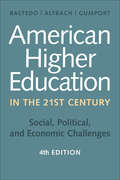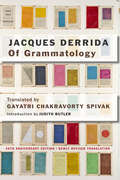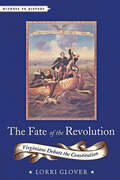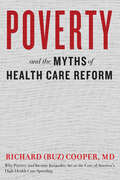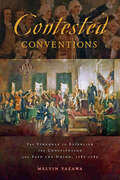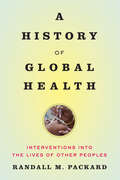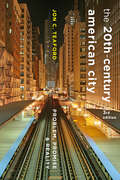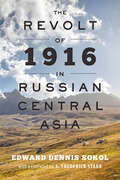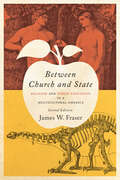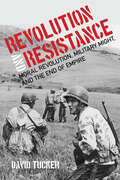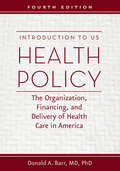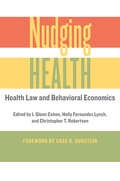- Table View
- List View
American Higher Education in the Twenty-First Century: Social, Political, and Economic Challenges
by Michael N. Bastedo Philip G. Altbach Patricia J. GumportFirst published in 1999, American Higher Education in the Twenty-First Century offered a comprehensive introduction to the central issues facing American colleges and universities. This thoroughly revised edition brings the classic volume up to date. The contributors have rewritten every chapter to address major changes in higher education, including the rise of organized social movements, the problem of income inequality and stratification, and the growth of for-profit and distance education. Three new chapters cover information technology, community colleges, and teaching and learning.This edition seeks to capture several crucial dynamics in the nexus of higher education and society. Placing higher education within its social and political contexts, the contributors discuss finance, federal and state governance, faculty, students, curriculum, and academic leadership. They also grapple with growing concerns about the future of the academy and reflect more deeply on the racial, ethnic, and socioeconomic diversity within higher education.No other book covers such wide-ranging issues under the broader theme of higher education;€™s relationship to society. Highly acclaimed and incorporating cutting-edge research, American Higher Education in the Twenty-First Century is now more useful and engaging than ever.Contributors: Michael N. Bastedo, Philip G. Altbach, Patricia J. Gumport, Benjamin Baez, Peter Riley Bahr, Joy Blanchard, Corbin M. Campbell, Melanie E. Corrigan, Peter D. Eckel, Roger L. Geiger, Lawrence E. Gladieux, Sara Goldrick-Rab, Jillian Leigh Gross, D. Bruce Johnstone, Adrianna Kezar, Jacqueline E. King, Aims C. McGuinness, Jr., Michael Mumper, Anna Neumann, Robert M. O;€™Neil, Laura W. Perna, Gary Rhoades, Roman Ruiz, Lauren Schudde, Sheila Slaughter, Daryl G. Smith
Of Grammatology
by Jacques DerridaJacques Derrida’s revolutionary approach to phenomenology, psychoanalysis, structuralism, linguistics, and indeed the entire European tradition of philosophyâ€�called deconstructionâ€�changed the face of criticism. It provoked a questioning of philosophy, literature, and the human sciences that these disciplines would have previously considered improper. Forty years after Of Grammatology first appeared in English, Derrida still ignites controversy, thanks in part to Gayatri Chakravorty Spivak’s careful translation, which attempted to capture the richness and complexity of the original. This fortieth anniversary edition, where a mature Spivak retranslates with greater awareness of Derrida’s legacy, also includes a new afterword by her which supplements her influential original preface. Judith Butler has added an introduction. All references in the work have been updated. One of contemporary criticism’s most indispensable works, Of Grammatology is made even more accessible and usable by this new release.
Of Grammatology
by Jacques DerridaJacques Derrida’s revolutionary approach to phenomenology, psychoanalysis, structuralism, linguistics, and indeed the entire European tradition of philosophyâ€�called deconstructionâ€�changed the face of criticism. It provoked a questioning of philosophy, literature, and the human sciences that these disciplines would have previously considered improper. Forty years after Of Grammatology first appeared in English, Derrida still ignites controversy, thanks in part to Gayatri Chakravorty Spivak’s careful translation, which attempted to capture the richness and complexity of the original. This fortieth anniversary edition, where a mature Spivak retranslates with greater awareness of Derrida’s legacy, also includes a new afterword by her which supplements her influential original preface. Judith Butler has added an introduction. All references in the work have been updated. One of contemporary criticism’s most indispensable works, Of Grammatology is made even more accessible and usable by this new release.
The Fate of the Revolution: Virginians Debate the Constitution (Witness to History)
by Lorri GloverIn May 1788, the roads into Richmond overflowed with horses and stagecoaches. From every county, specially elected representatives made their way to the capital city for the Virginia Ratification Convention. Together, these delegates;¢;‚¬;€?zealous advocates selected by Virginia;€™s deadlocked citizens;¢;‚¬;€?would decide to accept or reject the highly controversial United States Constitution, thus determining the fate of the American Republic. The rest of the country kept an anxious vigil, keenly aware that without the endorsement of Virginia;¢;‚¬;€?its largest and most populous state;¢;‚¬;€?the Constitution was doomed.In The Fate of the Revolution, Lorri Glover explains why Virginia;€™s wrangling over ratification led to such heated political debate. Beginning in 1787, when they first learned about the radical new government design, Virginians had argued about the proposed Constitution;€™s meaning and merits. The convention delegates, who numbered among the most respected and experienced patriots in Revolutionary America, were roughly split in their opinions. Patrick Henry, for example, the greatest orator of the age, opposed James Madison, the intellectual force behind the Constitution. The two sides were so evenly matched that in the last days of the convention, the savviest political observers still could not confidently predict the outcome.Mining an incredible wealth of sources, including letters, pamphlets, newspaper articles, and transcripts, Glover brings these remarkable political discussions to life. She raises the provocative, momentous constitutional questions that consumed Virginians, echoed across American history, and still resonate today. This engaging book harnesses the uncertainty and excitement of the Constitutional debates to show readers the clear departure the Constitution marked, the powerful reasons people had to view it warily, and the persuasive claims that Madison and his allies finally made with success.
The Fate of the Revolution: Virginians Debate the Constitution (Witness to History)
by Lorri GloverIn May 1788, the roads into Richmond overflowed with horses and stagecoaches. From every county, specially elected representatives made their way to the capital city for the Virginia Ratification Convention. Together, these delegates;¢;‚¬;€?zealous advocates selected by Virginia;€™s deadlocked citizens;¢;‚¬;€?would decide to accept or reject the highly controversial United States Constitution, thus determining the fate of the American Republic. The rest of the country kept an anxious vigil, keenly aware that without the endorsement of Virginia;¢;‚¬;€?its largest and most populous state;¢;‚¬;€?the Constitution was doomed.In The Fate of the Revolution, Lorri Glover explains why Virginia;€™s wrangling over ratification led to such heated political debate. Beginning in 1787, when they first learned about the radical new government design, Virginians had argued about the proposed Constitution;€™s meaning and merits. The convention delegates, who numbered among the most respected and experienced patriots in Revolutionary America, were roughly split in their opinions. Patrick Henry, for example, the greatest orator of the age, opposed James Madison, the intellectual force behind the Constitution. The two sides were so evenly matched that in the last days of the convention, the savviest political observers still could not confidently predict the outcome.Mining an incredible wealth of sources, including letters, pamphlets, newspaper articles, and transcripts, Glover brings these remarkable political discussions to life. She raises the provocative, momentous constitutional questions that consumed Virginians, echoed across American history, and still resonate today. This engaging book harnesses the uncertainty and excitement of the Constitutional debates to show readers the clear departure the Constitution marked, the powerful reasons people had to view it warily, and the persuasive claims that Madison and his allies finally made with success.
One Health and the Politics of Antimicrobial Resistance
by Laura H. KahnZoonoses;¢;‚¬;€?infectious diseases, such as SARS and mad cow, that originate in animals and spread to humans;¢;‚¬;€?reveal how intimately animal and human health are linked. Complicating this relationship further, when livestock are given antibiotics to increase growth, it can lead to resistant bacteria. Unfortunately, there are few formal channels for practitioners of human medicine and veterinary medicine to communicate about threats to public health. To address this problem, Dr. Laura H. Kahn and her colleagues are promoting the One Health concept, which seeks to increase communication and collaboration between professionals in human, animal, and environmental health.In One Health and the Politics of Antimicrobial Resistance, Dr. Kahn investigates the use of antibiotics and the surge in antimicrobial resistance in food animals and humans from a One Health perspective. Although the medical community has blamed the problem on agricultural practices, the agricultural community insists that antibiotic resistance is the result of indiscriminate use of antibiotics in human medicine. Dr. Kahn argues that this blame game has fueled the politics of antibiotic resistance and hindered the development of effective policies to address the worsening crisis.Combining painstaking research with unprecedented access to international data, the book analyzes the surprising outcomes of differing policy approaches to antibiotic resistance around the globe. By integrating the perspectives of both medicine and agriculture and exploring the history and science behind the widespread use of growth-promoting antibiotics, One Health and the Politics of Antimicrobial Resistance examines the controversy in a unique way while offering policy recommendations that all sides can accept.
One Health and the Politics of Antimicrobial Resistance
by Laura H. KahnZoonoses;¢;‚¬;€?infectious diseases, such as SARS and mad cow, that originate in animals and spread to humans;¢;‚¬;€?reveal how intimately animal and human health are linked. Complicating this relationship further, when livestock are given antibiotics to increase growth, it can lead to resistant bacteria. Unfortunately, there are few formal channels for practitioners of human medicine and veterinary medicine to communicate about threats to public health. To address this problem, Dr. Laura H. Kahn and her colleagues are promoting the One Health concept, which seeks to increase communication and collaboration between professionals in human, animal, and environmental health.In One Health and the Politics of Antimicrobial Resistance, Dr. Kahn investigates the use of antibiotics and the surge in antimicrobial resistance in food animals and humans from a One Health perspective. Although the medical community has blamed the problem on agricultural practices, the agricultural community insists that antibiotic resistance is the result of indiscriminate use of antibiotics in human medicine. Dr. Kahn argues that this blame game has fueled the politics of antibiotic resistance and hindered the development of effective policies to address the worsening crisis.Combining painstaking research with unprecedented access to international data, the book analyzes the surprising outcomes of differing policy approaches to antibiotic resistance around the globe. By integrating the perspectives of both medicine and agriculture and exploring the history and science behind the widespread use of growth-promoting antibiotics, One Health and the Politics of Antimicrobial Resistance examines the controversy in a unique way while offering policy recommendations that all sides can accept.
Poverty and the Myths of Health Care Reform
by Richard Buz CooperIn Poverty and the Myths of Health Care Reform, Dr. Richard (Buz) Cooper argues that US poverty and high health care spending are inextricably entwined. Our nation's health care system bears a financial burden that is greater than in any other developed country in large part because impoverished patients use more health care, driving up costs across the board.Drawing on decades of research, Dr. Cooper illuminates the geographic patterns of poverty, wealth, and health care utilization that exist across neighborhoods, regions, and states;¢;‚¬;€?and among countries. He chronicles the historical threads that have led to such differences, examines the approaches that have been taken to combat poverty throughout US history, and analyzes the impact that structural changes now envisioned for clinical practice are likely to have. His research reveals that ignoring the impact of low income on health care utilization while blaming rising costs on waste, inefficiency, and unnecessary care has led policy makers to reshape clinical practice in ways that impede providers who care for the poor.The first book to address the fundamental nexus that binds poverty and income inequality to soaring health care utilization and spending, Poverty and the Myths of Health Care Reform is a must-read for medical professionals, public health scholars, politicians, and anyone concerned with the heavy burden of inequality on the health of Americans.
Poverty and the Myths of Health Care Reform
by Richard Buz CooperIn Poverty and the Myths of Health Care Reform, Dr. Richard (Buz) Cooper argues that US poverty and high health care spending are inextricably entwined. Our nation's health care system bears a financial burden that is greater than in any other developed country in large part because impoverished patients use more health care, driving up costs across the board.Drawing on decades of research, Dr. Cooper illuminates the geographic patterns of poverty, wealth, and health care utilization that exist across neighborhoods, regions, and states;¢;‚¬;€?and among countries. He chronicles the historical threads that have led to such differences, examines the approaches that have been taken to combat poverty throughout US history, and analyzes the impact that structural changes now envisioned for clinical practice are likely to have. His research reveals that ignoring the impact of low income on health care utilization while blaming rising costs on waste, inefficiency, and unnecessary care has led policy makers to reshape clinical practice in ways that impede providers who care for the poor.The first book to address the fundamental nexus that binds poverty and income inequality to soaring health care utilization and spending, Poverty and the Myths of Health Care Reform is a must-read for medical professionals, public health scholars, politicians, and anyone concerned with the heavy burden of inequality on the health of Americans.
Contested Conventions: The Struggle to Establish the Constitution and Save the Union, 1787;€“1789
by Melvin YazawaThere is perhaps no more critical juncture in American history than the years in which Americans drafted the federal Constitution, fiercely debated its merits and failings, and adopted it, albeit with reservations. In Contested Conventions, senior historian Melvin Yazawa examines the political and ideological clashes that accompanied the transformation of the country from a loose confederation of states to a more perfect union.Treating the 1787;€“1789 period as a whole, the book highlights the contingent nature of the struggle to establish the Constitution and brings into focus the overriding concern of the framers and ratifiers, who struggled to counter what Alexander Hamilton identified as the "centrifugal" forces driving Americans toward a disastrous disunion. This concern inspired the delegates in Philadelphia to resolve through compromise the two most divisive confrontations of the Constitutional Convention;¢;‚¬;€?representation in the new Congress and slavery;¢;‚¬;€?and was instrumental in gaining ratification even in states where Antifederalist delegates comprised a substantial majority.Arguing that the debates over ratification reflected competing ideas about the meaning of American nationhood, Yazawa illuminates the nature of the crisis that necessitated the meeting at Philadelphia in the first place. Contested Conventions is a cohesive and compelling account of the defining issues that led to the establishment of the Constitution; it should appeal to history students and scholars alike.
Contested Conventions: The Struggle to Establish the Constitution and Save the Union, 1787;€“1789
by Melvin YazawaThere is perhaps no more critical juncture in American history than the years in which Americans drafted the federal Constitution, fiercely debated its merits and failings, and adopted it, albeit with reservations. In Contested Conventions, senior historian Melvin Yazawa examines the political and ideological clashes that accompanied the transformation of the country from a loose confederation of states to a more perfect union.Treating the 1787;€“1789 period as a whole, the book highlights the contingent nature of the struggle to establish the Constitution and brings into focus the overriding concern of the framers and ratifiers, who struggled to counter what Alexander Hamilton identified as the "centrifugal" forces driving Americans toward a disastrous disunion. This concern inspired the delegates in Philadelphia to resolve through compromise the two most divisive confrontations of the Constitutional Convention;¢;‚¬;€?representation in the new Congress and slavery;¢;‚¬;€?and was instrumental in gaining ratification even in states where Antifederalist delegates comprised a substantial majority.Arguing that the debates over ratification reflected competing ideas about the meaning of American nationhood, Yazawa illuminates the nature of the crisis that necessitated the meeting at Philadelphia in the first place. Contested Conventions is a cohesive and compelling account of the defining issues that led to the establishment of the Constitution; it should appeal to history students and scholars alike.
A History of Global Health: Interventions into the Lives of Other Peoples
by Randall M. PackardOver the past century, hundreds of billions of dollars have been invested in programs aimed at improving health on a global scale. Given the enormous scale and complexity of these lifesaving operations, why do millions of people in low-income countries continue to live without access to basic health services, sanitation, or clean water? And why are deadly diseases like Ebola able to spread so quickly among populations?In A History of Global Health, Randall M. Packard argues that global-health initiatives have saved millions of lives but have had limited impact on the overall health of people living in underdeveloped areas, where health-care workers are poorly paid, infrastructure and basic supplies such as disposable gloves, syringes, and bandages are lacking, and little effort has been made to address the underlying social and economic determinants of ill health. Global-health campaigns have relied on the application of biomedical technologies;¢;‚¬;€?vaccines, insecticide-treated nets, vitamin A capsules;¢;‚¬;€?to attack specific health problems but have failed to invest in building lasting infrastructure for managing the ongoing health problems of local populations.Designed to be read and taught, the book offers a critical historical view, providing historians, policy makers, researchers, program managers, and students with an essential new perspective on the formation and implementation of global-health policies and practices.
A History of Global Health: Interventions into the Lives of Other Peoples
by Randall M. PackardOver the past century, hundreds of billions of dollars have been invested in programs aimed at improving health on a global scale. Given the enormous scale and complexity of these lifesaving operations, why do millions of people in low-income countries continue to live without access to basic health services, sanitation, or clean water? And why are deadly diseases like Ebola able to spread so quickly among populations?In A History of Global Health, Randall M. Packard argues that global-health initiatives have saved millions of lives but have had limited impact on the overall health of people living in underdeveloped areas, where health-care workers are poorly paid, infrastructure and basic supplies such as disposable gloves, syringes, and bandages are lacking, and little effort has been made to address the underlying social and economic determinants of ill health. Global-health campaigns have relied on the application of biomedical technologies;¢;‚¬;€?vaccines, insecticide-treated nets, vitamin A capsules;¢;‚¬;€?to attack specific health problems but have failed to invest in building lasting infrastructure for managing the ongoing health problems of local populations.Designed to be read and taught, the book offers a critical historical view, providing historians, policy makers, researchers, program managers, and students with an essential new perspective on the formation and implementation of global-health policies and practices.
The Twentieth-Century American City: Problem, Promise, and Reality (The American Moment)
by Jon C. TeafordThroughout the twentieth century, the city was deemed a problematic space, one that Americans urgently needed to improve. Although cities from New York to Los Angeles served as grand monuments to wealth and enterprise, they also reflected the social and economic fragmentation of the nation. Race, ethnicity, and class splintered the metropolis both literally and figuratively, thwarting efforts to create a harmonious whole. The urban landscape revealed what was right;¢;‚¬;€?and wrong;¢;‚¬;€?with both the country and its citizens;€™ way of life. In this thoroughly revised edition of his highly acclaimed book, Jon C. Teaford updates the story of urban America by expanding his discussion to cover the end of the twentieth century and the first years of the next millennium. A new chapter on urban revival initiatives at the close of the century focuses on the fight over suburban sprawl as well as the mixed success of reimagining historic urban cores as hip new residential and cultural hubs. The book also explores the effects of the late-century immigration boom from Latin America and Asia, which has complicated the metropolitan ethnic portrait.Drawing on wide-ranging primary and secondary sources, Teaford describes the complex social, political, economic, and physical development of US urban areas over the course of the long twentieth century. Touching on aging central cities, technoburbs, and the ongoing conflict between inner-city poverty and urban boosterism, The Twentieth-Century American City offers a broad, accessible overview of America;€™s persistent struggle for a better city.
The Twentieth-Century American City: Problem, Promise, and Reality (The American Moment)
by Jon C. TeafordThroughout the twentieth century, the city was deemed a problematic space, one that Americans urgently needed to improve. Although cities from New York to Los Angeles served as grand monuments to wealth and enterprise, they also reflected the social and economic fragmentation of the nation. Race, ethnicity, and class splintered the metropolis both literally and figuratively, thwarting efforts to create a harmonious whole. The urban landscape revealed what was right;¢;‚¬;€?and wrong;¢;‚¬;€?with both the country and its citizens;€™ way of life. In this thoroughly revised edition of his highly acclaimed book, Jon C. Teaford updates the story of urban America by expanding his discussion to cover the end of the twentieth century and the first years of the next millennium. A new chapter on urban revival initiatives at the close of the century focuses on the fight over suburban sprawl as well as the mixed success of reimagining historic urban cores as hip new residential and cultural hubs. The book also explores the effects of the late-century immigration boom from Latin America and Asia, which has complicated the metropolitan ethnic portrait.Drawing on wide-ranging primary and secondary sources, Teaford describes the complex social, political, economic, and physical development of US urban areas over the course of the long twentieth century. Touching on aging central cities, technoburbs, and the ongoing conflict between inner-city poverty and urban boosterism, The Twentieth-Century American City offers a broad, accessible overview of America;€™s persistent struggle for a better city.
The Revolt of 1916 in Russian Central Asia (The Johns Hopkins University Studies in Historical and Political Science #71)
by Edward Dennis SokolDuring the summer of 1916, approximately 270,000 Central Asians;¢;‚¬;€?Kazakhs, Kyrgyz, Tajiks, Turkmen, and Uzbeks;¢;‚¬;€?perished at the hands of the Russian army in a revolt that began with resistance to the Tsar;€™s World War I draft. In addition to those killed outright, tens of thousands of men, women, and children died while trying to escape over treacherous mountain passes into China. Experts calculate that the Kyrgyz, who suffered most heavily, lost 40% of their total population. This horrific incident was nearly lost to history. During the Soviet era, the massacre of 1916 became a taboo subject, hidden in sealed archives and banished from history books. Edward Dennis Sokol;€™s pioneering Revolt of 1916 in Russian Central Asia, published in 1954 and reissued now for the first time in decades, was for generations the only scholarly study of the massacre in any language. Drawing on early Soviet periodicals, including Krasnyi Arkhiv (The Red Archive), Sokol;€™s wide-ranging and exhaustively researched work explores the Tsarist policies that led to Russian encroachment against the land and rights of the indigenous Central Asian people. It describes the corruption that permeated Russian colonial rule and argues that the uprising was no mere draft riot, but a revolt against Tsarist colonialism in all its dimensions: economic, political, religious, and national. Sokol;€™s masterpiece also traces the chain reaction between the uprising, the collapse of Tsarism, and the Bolshevik Revolution. A classic study of a vanished world, Sokol's work takes on contemporary resonance in light of Vladimir Putin;€™s heavy-handed efforts to persuade Kyrgyzstan to join his new economic union. Sokol explains how;‚ an earlier Russian conquest ended in;‚ disaster and;‚ implies that a;‚ modern;‚ conquest might have the same effect. Essential reading for historians, political scientists, and policymakers, this reissued edition is being published to coincide with the centennial observation of the genocide.
The Revolt of 1916 in Russian Central Asia (The Johns Hopkins University Studies in Historical and Political Science #71)
by Edward Dennis SokolDuring the summer of 1916, approximately 270,000 Central Asians;¢;‚¬;€?Kazakhs, Kyrgyz, Tajiks, Turkmen, and Uzbeks;¢;‚¬;€?perished at the hands of the Russian army in a revolt that began with resistance to the Tsar;€™s World War I draft. In addition to those killed outright, tens of thousands of men, women, and children died while trying to escape over treacherous mountain passes into China. Experts calculate that the Kyrgyz, who suffered most heavily, lost 40% of their total population. This horrific incident was nearly lost to history. During the Soviet era, the massacre of 1916 became a taboo subject, hidden in sealed archives and banished from history books. Edward Dennis Sokol;€™s pioneering Revolt of 1916 in Russian Central Asia, published in 1954 and reissued now for the first time in decades, was for generations the only scholarly study of the massacre in any language. Drawing on early Soviet periodicals, including Krasnyi Arkhiv (The Red Archive), Sokol;€™s wide-ranging and exhaustively researched work explores the Tsarist policies that led to Russian encroachment against the land and rights of the indigenous Central Asian people. It describes the corruption that permeated Russian colonial rule and argues that the uprising was no mere draft riot, but a revolt against Tsarist colonialism in all its dimensions: economic, political, religious, and national. Sokol;€™s masterpiece also traces the chain reaction between the uprising, the collapse of Tsarism, and the Bolshevik Revolution. A classic study of a vanished world, Sokol's work takes on contemporary resonance in light of Vladimir Putin;€™s heavy-handed efforts to persuade Kyrgyzstan to join his new economic union. Sokol explains how;‚ an earlier Russian conquest ended in;‚ disaster and;‚ implies that a;‚ modern;‚ conquest might have the same effect. Essential reading for historians, political scientists, and policymakers, this reissued edition is being published to coincide with the centennial observation of the genocide.
Between Church and State: Religion and Public Education in a Multicultural America
by James W. FraserToday, the ongoing controversy about the place;¢;‚¬;€?or lack of place;¢;‚¬;€?of religion in public schools is a burning issue in the United States. Prayer at football games, creationism in the classroom, the teaching of religion and morals, and public funding for private religious schools are just a few of the subjects over which people are skirmishing. In Between Church and State, historian and pastor James W. Fraser shows that these battles have been going on for as long as there have been public schools and argues there has never been any consensus about what the "separation of church and state" means for American society or about the proper relationship between religion and public education.Looking at the difficult question of how private issues of faith can be reconciled with the very public nature of schooling, Fraser;€™s classic book paints a complex picture of how a multicultural society struggles to take the deep commitments of people of faith into account;¢;‚¬;€?including people of many different faiths and no faith. In this fully updated second edition, Fraser tackles the culture wars, adding fresh material on current battles over public funding for private religious schools. He also addresses the development of the long-simmering evolution-creationism debate and explores the tensions surrounding a discussion of religion and the accommodation of an increasingly religiously diverse American student body.Between Church and State includes new scholarship on the role of Roger Williams and William Penn in developing early American conceptions of religious liberty. It traces the modern expansion of Catholic parochial schools and closely examines the passage of the First Amendment, changes in American Indian tribal education, the place of religion in Booker T. Washington and W. E. B. Du Bois;€™s debates about African American schooling, and the rapid growth of Jewish day schools among a community previously known for its deep commitment to secular public education.
Between Church and State: Religion and Public Education in a Multicultural America
by James W. FraserToday, the ongoing controversy about the place;¢;‚¬;€?or lack of place;¢;‚¬;€?of religion in public schools is a burning issue in the United States. Prayer at football games, creationism in the classroom, the teaching of religion and morals, and public funding for private religious schools are just a few of the subjects over which people are skirmishing. In Between Church and State, historian and pastor James W. Fraser shows that these battles have been going on for as long as there have been public schools and argues there has never been any consensus about what the "separation of church and state" means for American society or about the proper relationship between religion and public education.Looking at the difficult question of how private issues of faith can be reconciled with the very public nature of schooling, Fraser;€™s classic book paints a complex picture of how a multicultural society struggles to take the deep commitments of people of faith into account;¢;‚¬;€?including people of many different faiths and no faith. In this fully updated second edition, Fraser tackles the culture wars, adding fresh material on current battles over public funding for private religious schools. He also addresses the development of the long-simmering evolution-creationism debate and explores the tensions surrounding a discussion of religion and the accommodation of an increasingly religiously diverse American student body.Between Church and State includes new scholarship on the role of Roger Williams and William Penn in developing early American conceptions of religious liberty. It traces the modern expansion of Catholic parochial schools and closely examines the passage of the First Amendment, changes in American Indian tribal education, the place of religion in Booker T. Washington and W. E. B. Du Bois;€™s debates about African American schooling, and the rapid growth of Jewish day schools among a community previously known for its deep commitment to secular public education.
Revolution and Resistance: Moral Revolution, Military Might, and the End of Empire
by David TuckerIn this provocative history, David Tucker argues that "irregular warfare";¢;‚¬;€?including terrorism, guerrilla warfare, and other insurgency tactics;¢;‚¬;€?is intimately linked to the rise and decline of Euro-American empire around the globe. Tracing the evolution of resistance warfare from the age of the conquistadors through the United States;€™ recent ventures in Afghanistan and Iraq, Revolution and Resistance demonstrates that contemporary conflicts in the Middle East, Africa, and Asia are simply the final stages in the unraveling of Euro-American imperialism. Tucker explores why it was so difficult for indigenous people and states to resist imperial power, which possessed superior military technology and was driven by a curious moral imperative to conquer. He also explains how native populations eventually learned to fight back by successfully combining guerrilla warfare with political warfare. By exploiting certain Euro-American weaknesses;¢;‚¬;€?above all, the instability created by the fading rationale for empire;¢;‚¬;€?insurgents were able to subvert imperialism by using its own ideologies against it. Tucker also examines how the development of free trade and world finance began to undermine the need for direct political control of foreign territory.Touching on Pontiac;€™s Rebellion of 1763, Abd el-Kader;€™s jihad in nineteenth-century Algeria, the national liberation movements that arose in twentieth-century Palestine, Vietnam, and Ireland, and contemporary terrorist activity, Revolution and Resistance shows how changing means have been used to wage the same struggle. Emphasizing moral rather than economic or technological explanations for the rise and fall of Euro-American imperialism, this concise, comprehensive book is required reading for anyone seeking to understand the character of contemporary conflict.
Revolution and Resistance: Moral Revolution, Military Might, and the End of Empire
by David TuckerIn this provocative history, David Tucker argues that "irregular warfare";¢;‚¬;€?including terrorism, guerrilla warfare, and other insurgency tactics;¢;‚¬;€?is intimately linked to the rise and decline of Euro-American empire around the globe. Tracing the evolution of resistance warfare from the age of the conquistadors through the United States;€™ recent ventures in Afghanistan and Iraq, Revolution and Resistance demonstrates that contemporary conflicts in the Middle East, Africa, and Asia are simply the final stages in the unraveling of Euro-American imperialism. Tucker explores why it was so difficult for indigenous people and states to resist imperial power, which possessed superior military technology and was driven by a curious moral imperative to conquer. He also explains how native populations eventually learned to fight back by successfully combining guerrilla warfare with political warfare. By exploiting certain Euro-American weaknesses;¢;‚¬;€?above all, the instability created by the fading rationale for empire;¢;‚¬;€?insurgents were able to subvert imperialism by using its own ideologies against it. Tucker also examines how the development of free trade and world finance began to undermine the need for direct political control of foreign territory.Touching on Pontiac;€™s Rebellion of 1763, Abd el-Kader;€™s jihad in nineteenth-century Algeria, the national liberation movements that arose in twentieth-century Palestine, Vietnam, and Ireland, and contemporary terrorist activity, Revolution and Resistance shows how changing means have been used to wage the same struggle. Emphasizing moral rather than economic or technological explanations for the rise and fall of Euro-American imperialism, this concise, comprehensive book is required reading for anyone seeking to understand the character of contemporary conflict.
Introduction to US Health Policy: The Organization, Financing, and Delivery of Health Care in America
by Donald A. BarrHealth care reform has been a dominant theme in public discourse for decades now. The passage of the Affordable Care Act was a major milestone, but rather than quell the rhetoric, it has sparked even more heated debate. In the latest edition of Introduction to US Health Policy, Donald A. Barr reviews the current structure of the American health care system, describing the historical and political contexts in which it developed and the core policy issues that continue to confront us today.Barr;€™s comprehensive analysis explores the various organizations and institutions that make the US health care system work;¢;‚¬;€?or fail to work. He describes in detail the paradox of US health care;¢;‚¬;€?simultaneously the best in the world and one of the worst among developed countries;¢;‚¬;€?while introducing readers to broad cultural issues surrounding health care policy, such as access, affordability, and quality. Barr also discusses specific elements of US health care with depth and nuance, including insurance, especially Medicare and Medicaid. He scrutinizes the shift to for-profit managed care while analyzing the pharmaceutical industry, issues surrounding long-term care, the plight of the uninsured, the prevalence of medical errors, and the troublesome issue of nursing shortages. The thoroughly updated edition of this widely adopted text focuses on the Affordable Care Act. It explains the steps taken to carry out the Act, the changes to the Act based on recent Supreme Court decisions, the success of the Act in achieving the combined goals of improved access to care and constraining the costs of care, and the continuing political controversy regarding its future. Drawing on an extensive range of resources, including government reports, scholarly publications, and analyses from a range of private organizations, Introduction to US Health Policy provides scholars, policymakers, and health care providers with a comprehensive platform of ideas that is key to understanding and influencing the changes in the US health care system.
Introduction to US Health Policy: The Organization, Financing, and Delivery of Health Care in America
by Donald A. BarrHealth care reform has been a dominant theme in public discourse for decades now. The passage of the Affordable Care Act was a major milestone, but rather than quell the rhetoric, it has sparked even more heated debate. In the latest edition of Introduction to US Health Policy, Donald A. Barr reviews the current structure of the American health care system, describing the historical and political contexts in which it developed and the core policy issues that continue to confront us today.Barr;€™s comprehensive analysis explores the various organizations and institutions that make the US health care system work;¢;‚¬;€?or fail to work. He describes in detail the paradox of US health care;¢;‚¬;€?simultaneously the best in the world and one of the worst among developed countries;¢;‚¬;€?while introducing readers to broad cultural issues surrounding health care policy, such as access, affordability, and quality. Barr also discusses specific elements of US health care with depth and nuance, including insurance, especially Medicare and Medicaid. He scrutinizes the shift to for-profit managed care while analyzing the pharmaceutical industry, issues surrounding long-term care, the plight of the uninsured, the prevalence of medical errors, and the troublesome issue of nursing shortages. The thoroughly updated edition of this widely adopted text focuses on the Affordable Care Act. It explains the steps taken to carry out the Act, the changes to the Act based on recent Supreme Court decisions, the success of the Act in achieving the combined goals of improved access to care and constraining the costs of care, and the continuing political controversy regarding its future. Drawing on an extensive range of resources, including government reports, scholarly publications, and analyses from a range of private organizations, Introduction to US Health Policy provides scholars, policymakers, and health care providers with a comprehensive platform of ideas that is key to understanding and influencing the changes in the US health care system.
Nudging Health: Health Law and Behavioral Economics
by I. Glenn Cohen Holly Fernandez Lynch Christopher T. Robertson Cass R. SunsteinBehavioral nudges are everywhere: calorie counts on menus, automated text reminders to encourage medication adherence, a reminder bell when a driver;€™s seatbelt isn;€™t fastened. Designed to help people make better health choices, these reminders have become so commonplace that they often go unnoticed. In Nudging Health, forty-five experts in behavioral science and health policy from across academia, government, and private industry come together to explore whether and how these tools are effective in improving health outcomes.Behavioral science has swept the fields of economics and law through the study of nudges, cognitive biases, and decisional heuristics;¢;‚¬;€?but it has only recently begun to impact the conversation on health care. Nudging Health wrestles with some of the thorny philosophical issues, legal limits, and conceptual questions raised by behavioral science as applied to health law and policy. The volume frames the fundamental issues surrounding health nudges by addressing ethical questions. Does cost-sharing for health expenditures cause patients to make poor decisions? Is it right to make it difficult for people to opt out of having their organs harvested for donation when they die? Are behavioral nudges paternalistic? The contributors examine specific applications of behavioral science, including efforts to address health care costs, improve vaccination rates, and encourage better decision-making by physicians. They wrestle with questions regarding the doctor-patient relationship and defaults in healthcare while engaging with larger, timely questions of healthcare reform.Nudging Health is the first multi-voiced assessment of behavioral economics and health law to span such a wide array of issues;¢;‚¬;€?from the Affordable Care Act to prescription drugs.Contributors: David A. Asch, Jerry Avorn, Jennifer Blumenthal-Barby, Alexander M. Capron, Niteesh K. Choudhry, I. Glenn Cohen, Sarah Conly, Gregory Curfman, Khaled El Emam, Barbara J. Evans, Nir Eyal, Andrea Freeman, Alan M. Garber, Jonathan Gingerich, Michael Hallsworth, Jim Hawkins, David Huffman, David A. Hyman, Julika Kaplan, Aaron S. Kesselheim, Nina A. Kohn, Russell Korobkin, Jeffrey T. Kullgren, Matthew J.B. Lawrence, George Loewenstein, Holly Fernandez Lynch, Ester Moher, Abigail R. Moncrieff, David Orentlicher, Manisha Padi, Christopher T. Robertson, Ameet Sarpatwari, Aditi P. Sen, Neel Shah, Zainab Shipchandler, Anna D. Sinaiko, Donna Spruijt-Metz, Cass R. Sunstein, Thomas S. Ulen, Kristen Underhill, Kevin G. Volpp, Mark D. White, David V. Yokum, Jennifer L. Zamzow, Richard J. Zeckhauser
Nudging Health: Health Law and Behavioral Economics
by I. Glenn Cohen Holly Fernandez Lynch Christopher T. Robertson Cass R. SunsteinBehavioral nudges are everywhere: calorie counts on menus, automated text reminders to encourage medication adherence, a reminder bell when a driver;€™s seatbelt isn;€™t fastened. Designed to help people make better health choices, these reminders have become so commonplace that they often go unnoticed. In Nudging Health, forty-five experts in behavioral science and health policy from across academia, government, and private industry come together to explore whether and how these tools are effective in improving health outcomes.Behavioral science has swept the fields of economics and law through the study of nudges, cognitive biases, and decisional heuristics;¢;‚¬;€?but it has only recently begun to impact the conversation on health care. Nudging Health wrestles with some of the thorny philosophical issues, legal limits, and conceptual questions raised by behavioral science as applied to health law and policy. The volume frames the fundamental issues surrounding health nudges by addressing ethical questions. Does cost-sharing for health expenditures cause patients to make poor decisions? Is it right to make it difficult for people to opt out of having their organs harvested for donation when they die? Are behavioral nudges paternalistic? The contributors examine specific applications of behavioral science, including efforts to address health care costs, improve vaccination rates, and encourage better decision-making by physicians. They wrestle with questions regarding the doctor-patient relationship and defaults in healthcare while engaging with larger, timely questions of healthcare reform.Nudging Health is the first multi-voiced assessment of behavioral economics and health law to span such a wide array of issues;¢;‚¬;€?from the Affordable Care Act to prescription drugs.Contributors: David A. Asch, Jerry Avorn, Jennifer Blumenthal-Barby, Alexander M. Capron, Niteesh K. Choudhry, I. Glenn Cohen, Sarah Conly, Gregory Curfman, Khaled El Emam, Barbara J. Evans, Nir Eyal, Andrea Freeman, Alan M. Garber, Jonathan Gingerich, Michael Hallsworth, Jim Hawkins, David Huffman, David A. Hyman, Julika Kaplan, Aaron S. Kesselheim, Nina A. Kohn, Russell Korobkin, Jeffrey T. Kullgren, Matthew J.B. Lawrence, George Loewenstein, Holly Fernandez Lynch, Ester Moher, Abigail R. Moncrieff, David Orentlicher, Manisha Padi, Christopher T. Robertson, Ameet Sarpatwari, Aditi P. Sen, Neel Shah, Zainab Shipchandler, Anna D. Sinaiko, Donna Spruijt-Metz, Cass R. Sunstein, Thomas S. Ulen, Kristen Underhill, Kevin G. Volpp, Mark D. White, David V. Yokum, Jennifer L. Zamzow, Richard J. Zeckhauser
